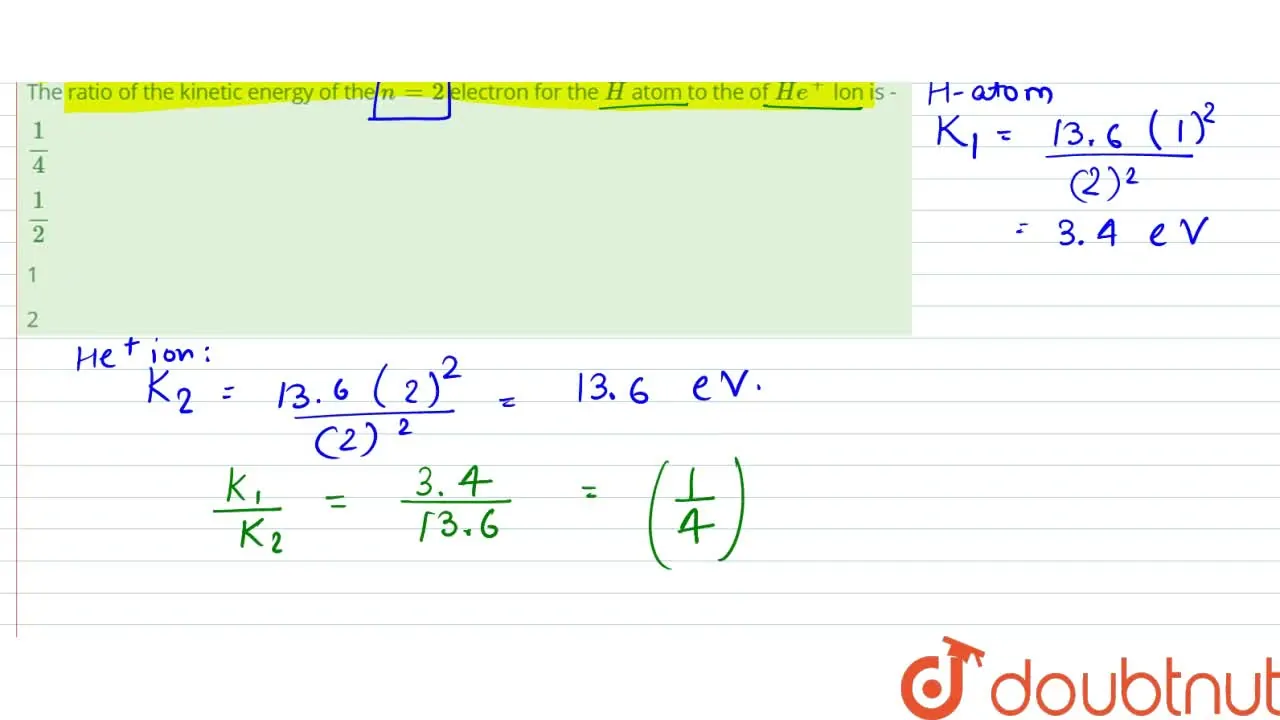In a mixture of is singly ionized He atom), H atom and ion are excited to their repectve first excite states. Subsequently , H atoms transfer their total excitation energy to ion (by collisitions). Assume that the Bohr model of atom is exctly valid.
The ratio of the kinetic energy of the electron for the H atom to that of ion is
Its potential energy decreases
Its kinetic energy increases
Its angular momentum remain unchanged
Wavelength of de Broglie wave associated with the electron decrease
The correct Answer is:A, B, C
As electron from higher to orbit hence
Similarly
Angular momentum hence as
hence Vn darr]lambda_(n) darr
Related Playlists
- BOOK - CENGAGE CHEMISTRY ENGLISHCHAPTER - ATOMIC STRUCTUREEXERCISE - Exercises Multiple Correct45videos
ATOMIC STRUCTURE
- BOOK - CENGAGE CHEMISTRY ENGLISHCHAPTER - ATOMIC STRUCTUREEXERCISE - Exercises Single Correct127videos
ATOMIC STRUCTURE
- BOOK - CENGAGE CHEMISTRY ENGLISHCHAPTER - ATOMIC STRUCTUREEXERCISE - Exercises (Subjective)52videos
ATOMIC STRUCTURE
- BOOK - CENGAGE CHEMISTRY ENGLISHCHAPTER - APPENDIX - INORGANIC VOLUME 1EXERCISE - chapter-7 Single correct answer1videos
APPENDIX - INORGANIC VOLUME 1
- BOOK - CENGAGE CHEMISTRY ENGLISHCHAPTER - CHEMICAL BONDING AND MOLECULAR STRUCTUREEXERCISE - Archives Subjective15videos
CHEMICAL BONDING AND MOLECULAR STRUCTURE
Similar Questions
In a mixture of H−He+ gas (He+is singly ionized He atom), H atom and He+ ions are excited to their respective first excited state. Subsequently H atoms transfer their total excitation energy to He+ ions (by collisions) Assume that the bohr model of atom is exactly valid.
The quantum number n of the state finally populated in He+ inos is -View SolutionIn a mixture of H−He+ gas (He+is singly ionized He atom), H atom and He+ ions are excited to their respective first excited state. Subsequently H atoms transfer their total excitation energy to He+ ions (by collisions) Assume that the bohr model of atom is exactly valid.
The quantum number n of the state finally populated in He+ inos is -View SolutionIn a mixture of H−He+ gas (He+ is singly ionized He atom), H atoms and He+ ions are excited to their respective first excited states. Subsequently, H atoms transfer their total excitation energy to He+ ions (by collisions). Assume that the Bohr model of atom is exctly valid.
The ratio of the kinetic energy of the n=2 electron for the H atom to that of He+ ion is:View SolutionIn a mixture of H−He+ gas (He+is singly ionized He atom), H atom and He+ ions are excited to their respective first excited state. Subsequently H atoms transfer their total excitation energy to He+ ions (by collisions) Assume that the bohr model of atom is exactly valid.
The ratio of the kinetic energy of the n=2 electron for the H atom to the of He+ lon is -View SolutionIn a mixture of H−He+ gas (He+is singly ionized He atom), H atom and He+ ions are excited to their respective first excited state. Subsequently H atoms transfer their total excitation energy to He+ ions (by collisions) Assume that the bohr model of atom is exactly valid.
The wavelength of light emitted in the visible region by He+ lons after collisions with H atoms is -View SolutionIn a mixture of H−He+ gas (He+is singly ionized He atom), H atom and He+ ions are excited to their respective first excited state. Subsequently H atoms transfer their total excitation energy to He+ ions (by collisions) Assume that the bohr model of atom is exactly valid.
The wavelength of light emitted in the visible region by He+ lons after collisions with H atoms is -View SolutionIn a mixture of He⊕ gas H atom and He⊕ ions Are excited to three respective first excited subsepuenly , H atom transfers its total excitation energy to He⊕ions by collision .Assuming that Bohr model of an atom is applicable , answer the following question
The ratio of teh potential energy of the n=2 electron for H atom to the of He⊕ ion isView SolutionIn a mixture of HeΘ gas H atom and HeΘ ions Are excited to three respective first excited subsepuenly , H atom transfers its total excitation energy to HeΘions by collision .Assuming that Bohr model of an atom is applicable , answer the following question
The wavelength of the light amitted in the visible region by HeΘ ions qaafter collisions with HeΘion isView SolutionFind the excitation energy of n = 3 level of He atom
View SolutionIn a mixture of He⊕ gas H atom and He⊕ ions Are excited to three respective first excited subsepuenly , H atom transfers its total excitation energy to He⊕ions by collision .Assuming that Bohr model of an atom is applicable , answer the following question
If each hydrogen atom in the ground state of 1.0mol of H atom is excited by absorbing photon of energy 8.4eV,12.09eV and 15.0eV of energy then the number of spectral lines emitted is equal toView Solution


